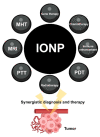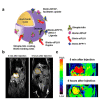Biocompatible Iron Oxide Nanoparticles for Targeted Cancer Gene Therapy: A Review
- PMID: 36234452
- PMCID: PMC9565336
- DOI: 10.3390/nano12193323
Biocompatible Iron Oxide Nanoparticles for Targeted Cancer Gene Therapy: A Review
Abstract
In recent years, gene therapy has made remarkable achievements in tumor treatment. In a successfully cancer gene therapy, a smart gene delivery system is necessary for both protecting the therapeutic genes in circulation and enabling high gene expression in tumor sites. Magnetic iron oxide nanoparticles (IONPs) have demonstrated their bright promise for highly efficient gene delivery target to tumor tissues, partly due to their good biocompatibility, magnetic responsiveness, and extensive functional surface modification. In this review, the latest progress in targeting cancer gene therapy is introduced, and the unique properties of IONPs contributing to the efficient delivery of therapeutic genes are summarized with detailed examples. Furthermore, the diagnosis potentials and synergistic tumor treatment capacity of IONPs are highlighted. In addition, aiming at potential risks during the gene delivery process, several strategies to improve the efficiency or reduce the potential risks of using IONPs for cancer gene therapy are introduced and addressed. The strategies and applications summarized in this review provide a general understanding for the potential applications of IONPs in cancer gene therapy.
Keywords: cancer treatment; gene delivery; iron oxide nanoparticles; tumor diagnosis; tumor targeting.
Conflict of interest statement
The authors declare no conflict of interest.
Figures








Similar articles
-
Iron Oxide Nanoparticles: Parameters for Optimized Photoconversion Efficiency in Synergistic Cancer Treatment.J Funct Biomater. 2024 Jul 25;15(8):207. doi: 10.3390/jfb15080207. J Funct Biomater. 2024. PMID: 39194645 Free PMC article. Review.
-
New Insights into Biocompatible Iron Oxide Nanoparticles: A Potential Booster of Gene Delivery to Stem Cells.Small. 2020 Sep;16(37):e2001588. doi: 10.1002/smll.202001588. Epub 2020 Jul 28. Small. 2020. PMID: 32725792 Review.
-
Iron oxide nanoparticle targeting mechanism and its application in tumor magnetic resonance imaging and therapy.Nanomedicine (Lond). 2022 Sep;17(21):1567-1583. doi: 10.2217/nnm-2022-0246. Epub 2022 Dec 2. Nanomedicine (Lond). 2022. PMID: 36458585 Review.
-
Surface engineering of magnetic iron oxide nanoparticles by polymer grafting: synthesis progress and biomedical applications.Nanoscale. 2020 Jul 23;12(28):14957-14975. doi: 10.1039/d0nr03346d. Nanoscale. 2020. PMID: 32648868 Review.
-
Advancements in Iron Oxide Nanoparticles for Multimodal Imaging and Tumor Theranostics.Curr Med Chem. 2024 Jul 12. doi: 10.2174/0109298673301359240705063544. Online ahead of print. Curr Med Chem. 2024. PMID: 39005127
Cited by
-
Recent developments in two-dimensional molybdenum disulfide-based multimodal cancer theranostics.J Nanobiotechnology. 2024 Aug 28;22(1):515. doi: 10.1186/s12951-024-02785-x. J Nanobiotechnology. 2024. PMID: 39198894 Free PMC article. Review.
-
Iron Oxide Nanoparticles: Parameters for Optimized Photoconversion Efficiency in Synergistic Cancer Treatment.J Funct Biomater. 2024 Jul 25;15(8):207. doi: 10.3390/jfb15080207. J Funct Biomater. 2024. PMID: 39194645 Free PMC article. Review.
-
Influence of Physicochemical Properties of Iron Oxide Nanoparticles on Their Antibacterial Activity.ACS Omega. 2024 Jul 25;9(31):33303-33334. doi: 10.1021/acsomega.4c02822. eCollection 2024 Aug 6. ACS Omega. 2024. PMID: 39130596 Free PMC article. Review.
-
Synergistic Immunoregulation: harnessing CircRNAs and PiRNAs to Amplify PD-1/PD-L1 Inhibition Therapy.Int J Nanomedicine. 2024 May 28;19:4803-4834. doi: 10.2147/IJN.S461289. eCollection 2024. Int J Nanomedicine. 2024. PMID: 38828205 Free PMC article. Review.
-
SPIONs: Superparamagnetic iron oxide-based nanoparticles for the delivery of microRNAi-therapeutics in cancer.Biomed Microdevices. 2024 Feb 7;26(1):16. doi: 10.1007/s10544-024-00698-y. Biomed Microdevices. 2024. PMID: 38324228 Review.
References
Publication types
Grants and funding
LinkOut - more resources
Full Text Sources

